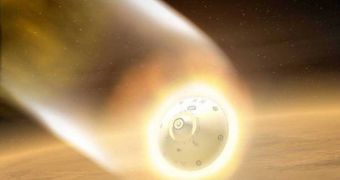Controlling a spacecraft while it exists or reenters the atmosphere, or while on the final descent for another moon or planet is a very tricky business, which currently requires years of planning, and just seconds to execute. For this very reason, the American enterprise Global Aerospace Corp. has announced that it's currently working on a new instrument that will help mission controllers gain the experience they need for the real thing. The new training device will be known as the Hypersonic Control Modeling and Simulation Tool (HyperCMST).
Among other applications for the new tool, the developer mentions aerodynamic orbital capture and aerodynamic gravity-assist capabilities as well, which means that the experts who will be using HyperCMST will have simulations of all the possible scenarios that may occur during an actual mission in this simulator. It will also be able to recreate the conditions that can be found on the surfaces of other planets, moons or asteroids, and could provide mission controllers and exploration vehicle designers with invaluable information about how their machines should be prepared for the task.
Needless to say, the NASA American space agency is very interested in the future system, which could be a nice “present” for its engineers. HyperCMST can model the optimum trajectories of a large number of very different spacecraft, and can also provide the readings necessary for the setup of an atmospheric capture system. NASA has already sponsored the first stage of the new project, through its Small Business Innovation Research (SBIR) program.
During this first stage, the developers at Global Aerospace Corp. will have to design a ballute (BALLoon-parachUTE) system, which is basically a very large inflatable object that can navigate through the atmosphere and that can also, at least in theory, make use of atmospheric drag to recover spacecraft stranded in orbit. Such an asset would undoubtedly be a great addition to NASA's fleet of craft, and situations such as the current one, where Atlantis will fly to Hubble and Endeavor will stand by for a rescue mission, could never be seen again.
Ballutes could potentially be used to slow down large cargo packages heading for Mars or the Moon. They would help decelerate the parcels even in the very thin Martian atmosphere, and would ensure that a human expedition has everything it needs to survive. Ultimately, HyperCMST will contain relevant data for most types of hypersonic craft, including the next-generation waveriders, which actually float on the shock waves they themselves produce.

 14 DAY TRIAL //
14 DAY TRIAL //